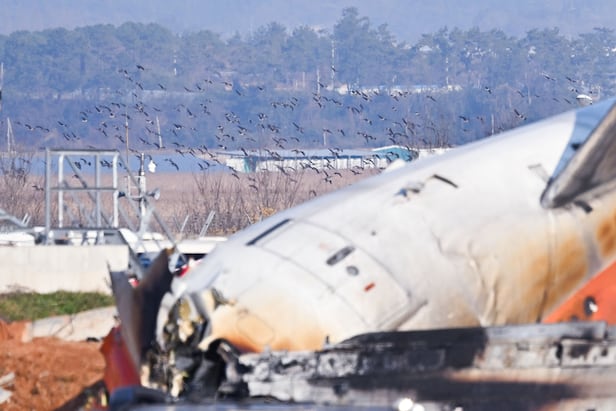The Dec. 29 crash of a Jeju Air passenger plane at Muan International Airport has brought renewed scrutiny to the airport’s design flaws and operational shortcomings. Experts point to several contributing factors, including the short runway, insufficient mitigation of bird strike risks identified during planning, and limited operational experience. Some critics link these issues to the airport’s politically driven development.
Opened in 2007, Muan International Airport was envisioned as a regional hub for South Korea’s southwest. Construction began in 1999 as part of a “political pledge” under the Kim Dae-jung administration. Despite initial projections of 9.92 million annual passengers, only 246,000 used the airport last year.

One critical issue is the airport’s 2.8-kilometer runway, shorter than most international airports. For comparison, runways at Incheon International Airport measure 3.75 kilometers, while those at Gimpo, Gimhae, and Jeju airports exceed 3 kilometers. Global hubs like JFK in New York and Charles de Gaulle in Paris often feature runways over 4 kilometers. The shorter runway at Muan also restricts operations of aircraft exceeding 400 tons.
Ongoing construction to extend the runway to 3.126 kilometers has further reduced its usable length to 2.5 kilometers. Experts emphasize that this limits the margin for error during emergencies.
“The current runway length is generally sufficient for routine operations but poses risks in emergency situations such as belly landings,” said Kim Kyu-hwan, director of the Korea Airports Corporation (KAC) Aviation Training Center. Kim In-kyu, head of Korea Aerospace University’s Flight Training Center, added, “While the runway length alone isn’t the sole cause of the accident, a longer runway might have reduced its severity.”
The Ministry of Land, Infrastructure, and Transport, however, downplayed the runway’s role, noting that the aircraft involved is capable of landing on runways as short as 1.5 kilometers.
Attention has also turned to bird strikes as a potential contributing factor. Experts suspect that a bird strike may have caused the failure of the plane’s landing gear.
Concerns about the airport’s exposure to bird strike risks have been raised since its inception. Over 12,000 migratory birds pass through the region annually, with the nearby Muan Tidal Flats serving as a vital stopover. Environmental impact assessments conducted during the airport’s planning phase flagged bird strikes as a significant risk, recommending measures like sound cannons, lasers, and warning lights. However, implementation has been delayed, reportedly due to ongoing runway extension work.
Muan Airport records the highest bird strike rate among South Korea’s airports, with 10 incidents reported between 2019 and August 2024. During that period, 11,004 flights operated at the airport, translating to a bird strike rate of 0.09%—significantly higher than Jeju’s 0.013% and Gimpo’s 0.018%.
Operational readiness has also come under scrutiny. Until December, Muan had not hosted regular international flights in its 17-year history. The Jeju Air flight involved in the crash was part of a new Muan-Bangkok route launched on Dec. 8, the airport’s first regular international service.
The KAC, which manages Muan Airport, has also been without a CEO for eight months following the resignation of its previous leader in April.
A former pilot noted procedural lapses during the emergency. “Following the bird strike warning and the ‘Mayday’ declaration, the situation escalated rapidly. Investigators need to determine whether air traffic control managed the emergency effectively and whether alternatives to the belly landing were considered,” the pilot said.


